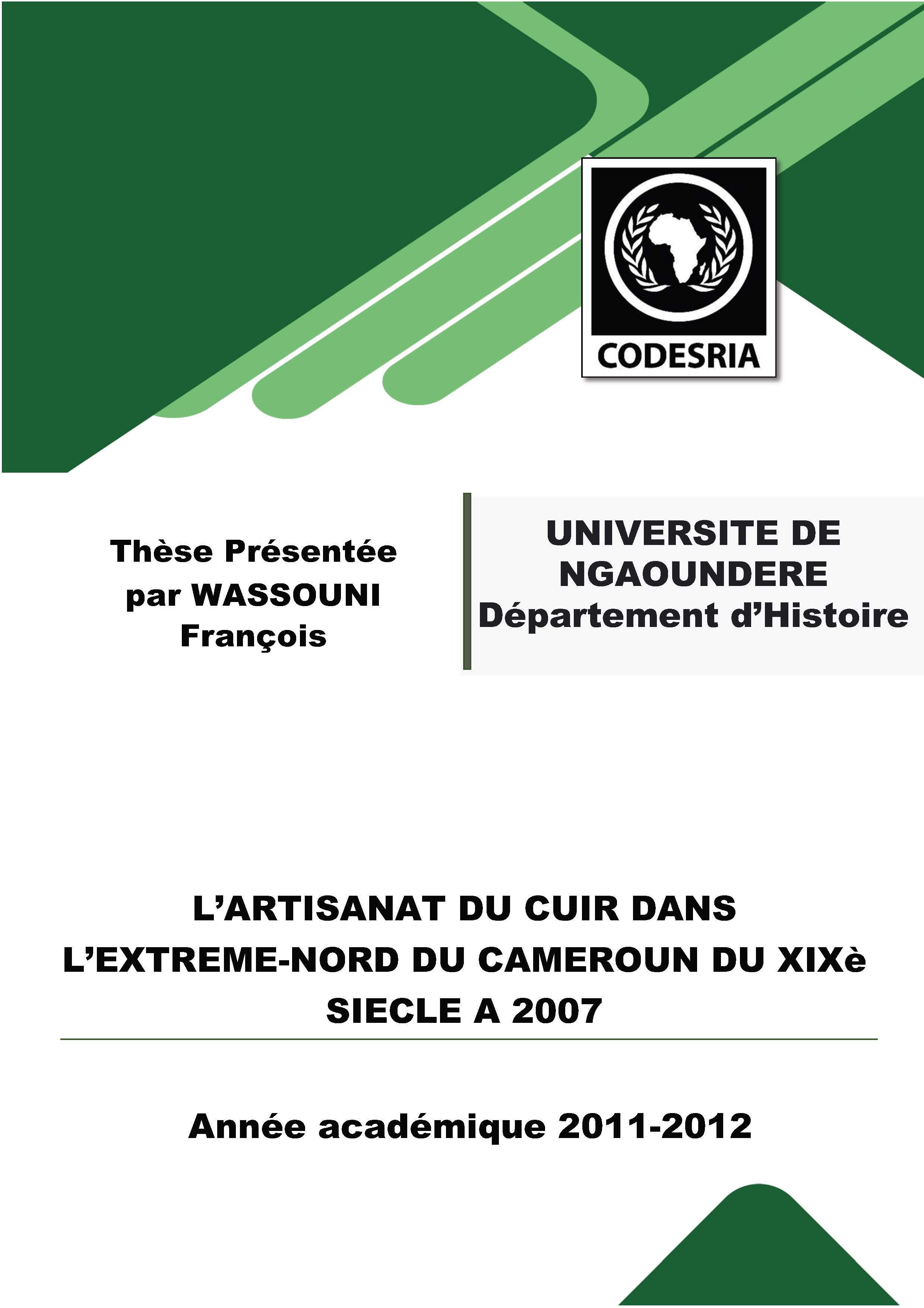L’ARTISANAT DU CUIR DANS L’EXTREME-NORD DU CAMEROUN DU XIXè SIECLE A 2007
Keywords:
Handicraft, Leather, production, transformation, trade, Far North, CameroonSynopsis
Based on different written documents, oral and iconographic sources and field observation, this work intends to analyse the evolution of leather activity within the context of its development, the methods of acquiring skins, the production, the use and the trade of leather and leather objects. This thesis emphasize also on the impact and the problems faced by the leather handicraft. It was between the 19th and the 20th centuries that pockets of leather activities in a high scale developed in the
localities of Maroua, Bogo, Mindif and Doumrou. It was introduced by the Kanuri and the Hausa peoples. The latter migrated into Northern Cameroon during the Fulani Jihad of the 19th century and developed traditional trade and industry in many domains among which was leather. Skins of animals such as cows, sheep and goats were transformed into leather through techniques which make use of products retrieved from nature in their majority. Fabricated items include prayer mats, covers for the Koran, shoes, war arsenals, G-strings and horse-riding paraphernalia destined to trade. Between the 1940s and 2007, Maroua leather artwork has particularly witnesses various changes caused by many factors. Measures taken by: the French colonial masters, the development of tourism and the advent of NGOs working the leather sector, the creation of associations, cooperative groups and common initiative groups, have contributed in changing the face of that sector of activity not only from the perspective of tanning, but also from the fabrication of leather objects. As a result of this, leather handicraft were organised, the models of products were then changed taking more and more the shape of western civilization. Such structures for the sale of leather objects have been created such as the Maroua Artisanal Centre in 1955 and the Artisanal Complex in 2007. In the other localities, however, leather artwork has not undergone major influences. Fabricated items objects remained almost the same as those of the 19th century. Those localities specialize more in tanning and the leather is forwarded to Maroua. From the 19th century to 2007, leather objects were sold in markets and other market centers created in localities of leather activities and their environs, in the areas of the ex-Adamawa Emirate, in the Southern parts of Cameroon, . These objects are also sold in other African and even European countries. The local populations, foreigners living in Cameroon, tourists and people from other parts of Cameroon are the main buyers of the Far Northern artworks. Objects which are fabricated serve various purposes especially for clothing, esoteric and esthetic purposes. In other localities of leather activity, the Kanuris and the Hausas have always taken the lead, whereas in Maroua, it does not go the same. The changes that took place there have contributed to break the ethnic monopoly and to involve people from diverse origins among whom some women. As an activity providing useful products for the people, the leather craftsmen thus occupied a privileged position in the 19th century society and even during the French colonial period in Maroua. The advent of modern products which progressively replaced those of local handicraft has had an impact on the social consideration on operators of this sector. In spite the prejudices on the leather work, it is worthy to note that in Maroua, for example, certain leather workers still enjoy a respectable social position thanks to their incomes. On the whole, leather craftsmanship has a multidimensional impact. It is a source of income to the whole chain of operators who are involved; it takes part to interethnic mixing, supplies the market of tourism and through its products, it contribute to the promotion of cultural identity of the Far North region worldwide however, it pollutes the environment through its nauseating smells and destroys it by the use of wild animals’ skins, attracts young school drop-outs thus contributing to illiteracy. For some years now, this local craft suffers from the scarcity of skins and other materials which contribute in tanning and the making of leather objects. Conflicts between craftsmen, leather products dealers, and NGOs mars this sector of activities whose products’ quality, sometimes doubtful, affects its sale.
Downloads
References
Abwa, D. et al. (éds.), 2000, Dynamiques d’intégration régionale en Afrique Centrale T.1&2, Yaoundé, PUY.
Adler, A., 1982, La mort est le masque du roi. La royauté sacrée des Moundang du Tchad, Paris, Payot.
Aets, J-P, Cogneau, D., 2000, L’économie du Cameroun. Un espoir évanoui, Paris, Karthala.
Anta Diop, C., 1979, Nations nègres et Culture, Paris, Présence Africaine, 3è édition.
Anta Diop, C., 1987, L’Afrique noire précoloniale, Paris, Présence Africaine.
ARPIN, R., 1992, Le Musée et la civilisation. Concepts et pratiques, Québec, Multimonde.
Audoin-Rouzeau, F. et Beyries, S. (dir.), 2002, Le travail du cuir de la Préhistoire à nos jours, XXIIè rencontres d’archéologie et d’histoire d’Antibes, Antibes, Editions APDCA.
Bah Thierno Mouctar, 1985, Architecture militaire traditionnelle et poliorcétique dans le Soudan occidental (du XVIIe à la fin du XIXe siècle), Yaoundé, Ed. Clé.
Bah Thierno Mouctar, (éd), 1998, Acteurs de l’histoire au Nord-Cameroun (XIXe –XXe siècles), N° spécial de la revue Ngaoundéré-Anthropos, Yaoundé, Imprimerie St-Paul.
Banque Mondiale, 2003, Patrimoine culturel de développement. Cadre d’action pour le Moyen-Orient et l’Afrique du Nord, Washington, Collection orientation du développement Barkindo Bawuro Mubi, 1989, The Sultanate of Mandara to 1902, Steiner, Stuttgart.
Baroin, C. et Boutrais, J., (éds.), 1999, L’homme et l’animal dans le bassin du Lac Tchad, Actes du colloque du réseau Méga-Tchad, Paris, Orléans, 15-17 octobre 1997, édition IRD.
Barreteau, D. et Tourneux, H, 1985, Le milieu et les hommes, recherches comparatives et historiques dans le bassin du Lac Tchad, Paris.






